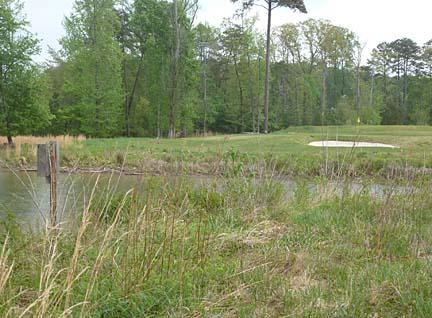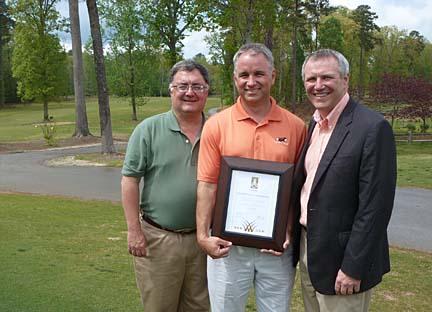 As head of the University of Tennessee turfgrass weed science research and extension program, Jim Brosnan, Ph.D., visits his fair share of golf courses, and he's continually inspired by the examples of innovation he sees on them. But it's always "what's next" that intrigues him when he visits The Bear Trace at Harrison Bay.
As head of the University of Tennessee turfgrass weed science research and extension program, Jim Brosnan, Ph.D., visits his fair share of golf courses, and he's continually inspired by the examples of innovation he sees on them. But it's always "what's next" that intrigues him when he visits The Bear Trace at Harrison Bay."To me, what's most impressive is that they are continually looking for ways to improve and ways to advance," Brosnan said during an Earth Day celebration at The Bear Trace at Harrison Bay on April 22.
The course near Chattanooga is one of nine state park golf facilities that comprise the Tennessee Golf Trail, and the facility and its superintendent, Paul Carter, CGCS, have developed a reputation for being a leader in environmental stewardship.
The Earth Day festivities marked (roughly) the one-year anniversary of when the golf course, thanks to a $400,000 grant from the Tennessee Department of Environment and Conservation, began using a new Jacobsen equipment fleet comprised almost exclusively of electric and hybrid technology.
One year later, Carter is able to quantify the impact of electric technology on his budget and the environment, which at Harrison Bay go hand-in-hand.
"Getting the equipment here, and this might sound selfish, was all about what can we accomplish here," Carter said. "Up to that point, all we had were estimates of what we could accomplish. Now, we can take these numbers to other courses. We hope people will look at us as a blueprint of what they can and should do."
Using the fleet of 18 pieces of electric equipment that includes seven Jacobsen mowers, five Toro MDE Workman vehicles, two TruTurf greensrollers, a pair of Smithco Super Star bunker rakes and two Club Car Carryall II vehicles, has led to a savings of more than 9,000 gallons in fuel (at about $2.35-$2.45 per gallon) and a reduction in carbon dioxide emissions of more than 180,000 pounds, according to Carter.
Converting to electric power is about more than saving money, it also is about taking that next step toward sustainability, which is important to Carter and his supervisor, Harrison Bay head pro Robin Boyer.
"One of the things with electric equipment is that it is more expensive, and you have to ask yourself why you are doing it. Is it for return on investment, or is it for the environment?" Carter said. "That's one of the reasons we were successful in getting the grant and the equipment here is because so much of what we do is based on how we are impacting the environment."
The new equipment also has helped Carter reduce equipment maintenance expenses by more than $30,000, virtually eliminate the threat of hydraulic and oil leaks, and reduce the noise associated with maintaining a golf course that doubles as a wildlife sanctuary.
That such accomplishments were achieved at a state-owned golf course rather than a private club has provided the rest of the industry with a blueprint for success."
"Robin and Paul have teamed together to set the benchmark for what we think can be a unique experience in a golf course environment," said park district deputy commissioner Brock Hill.
UT's Brosnan agreed.
"What the group here has done is an example to the whole industry," Brosnan said. "From electric mowing equipment with Jacobsen to the eagle project to taking areas out of play and out of mowed turf and what that is like in terms of water savings and savings of total resources, it's a great example of how to maximize resource savings on a golf course while also providing optimal playing conditions for the end user. It's important to communicate this as an example to other golf courses, not only in Tennessee, but beyond Tennessee."
 TurfNet's 2011 Superintendent of the Year, Carter also was named the public and overall winner of the Environmental Leaders in Golf Award from Golf Digest and the GCSAA for his efforts at promoting wildlife and sustainability at Harrison Bay. Those efforts include installation of 45 nesting boxes used by bluebirds and wrens, nesting boxes for wood ducks, reduced managed acreage on the golf course and overseeing the Harrison Bay Eagle Cam project that has brought the parenting skills of bald eagles to viewers around the world since 2011.
TurfNet's 2011 Superintendent of the Year, Carter also was named the public and overall winner of the Environmental Leaders in Golf Award from Golf Digest and the GCSAA for his efforts at promoting wildlife and sustainability at Harrison Bay. Those efforts include installation of 45 nesting boxes used by bluebirds and wrens, nesting boxes for wood ducks, reduced managed acreage on the golf course and overseeing the Harrison Bay Eagle Cam project that has brought the parenting skills of bald eagles to viewers around the world since 2011.While he has packed a lifetime of stewardship into a 22-year career, Carter always has an eye cast on the future.
Through Carter's efforts, Harrison Bay in April became certified by the Golf Environment Organization. Based in Scotland, GEO is dedicated to providing a credible and accessible system of sustainability standards, support programs, recognition and capacity building for the golf industry.
He currently is working toward converting gas-powered fairway and rough units to propane or bio-diesel and eventually wants to install solar panels to harness electric power.
Carter's vision is what makes Harrison Bay and Jacobsen such good partners for sustainability projects, said the latter's president, David Withers.
"We have a company mantra that says ?my performance today is not good enough for tomorrow,' " Withers said.
"I think it is really important that golf lives up to its environmental credentials. It's good that we are as good as we are, but I think we should always be striving to improve."
And, Brosnan said, tell others outside the industry what is taking place.
"I think it's great that we have a conversation about environmental sustainability and turf management in the golf industry," he said. "We need to have more of these conversations beyond Earth Day, and to continue to communicate as an industry about what we do to manage turfgrass for golf courses when it comes to preserving the environment."

